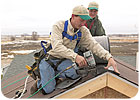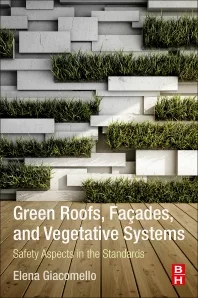TECHNICAL DETAILS: Proper Ventilation for Shingled Roofs
Proper ventilation is required for the long-term success of shingles. The performance of the shingles can be affected by insufficient interior ventilation throughout the year.

Proper ventilation is required for the long-term success of shingles. The performance of the shingles can be affected by insufficient interior ventilation throughout the year. In cold weather, internal functions such as showers, cooking and household appliances can generate warm air that - if not ventilated - can lead to condensation problems from moisture buildup in the basement and attic areas. In hot weather, improper ventilation can lead to interior humidity that can waste energy and cause premature aging of roof decks and shingles. These problems can be avoided with a balanced ventilation system.
Proper roof ventilation allows the outside air to flow up and out of the attic in a natural flow. It minimizes the temperature differential between the attic and outside air. This leads to a cooler, drier attic space, which prevents moisture from becoming trapped in the roof components (the deck, underlayment and shingles). It prevents damage to interior walls from paint peeling, mildew and rotting. It also reduces exterior damage from ice dams and warped exterior siding. With proper attic ventilation, energy consumption is reduced and both heating and cooling costs are lowered throughout the course of the year.
Improperly ventilated attic spaces create several problems for roof system components. Deck deflection can occur from warped or deteriorated roof deck wood created by long-term exposure to moisture (condensation). Water that condenses on all internal and external metal components will lead to rust and corrosion of the metal components, including nail heads and HVAC straps and flanges. In cold climates, a high interior humidity level (from appliances, showers, etc.) coupled with low outside temperatures can cause frost formation at the interior side of the deck. This situation can lead to dry rot of the wood. Moisture in insulation reduces its thermal capacity and will also lead to the formation of dry rot, fungi and mold. At exterior points, ice dam formation occurs from water continually refreezing at the roof perimeter. This often leads to leaks from the backup of water under the shingles. All of these conditions can contribute to shingle deterioration.

Intake vents are located at the eaves or underside edge of the roof and they allow fresh air to flow into the attic. Exhaust vents are located near the ridge or on the ridgeline and they allow air to leave the attic. Most roofing industry professionals agree that in most applications the most effective means of ventilation are through the use of continuous soffit and ridge ventilation. This method provides equal ventilation throughout the entire length of the area.
If alternate forms of ventilation are used, a calculation determining how much venting an attic area needs is required. Determination of required venting should be completed using the 1/300 rule, which states that there should be one square foot of ventilation for each 300 square feet of attic floor space. (Note that some building codes require a 1/150 rule, so you must check the local code prior to installation.) To complete the calculation, divide the total attic floor space by 300 (or 150 depending on the local code). This provides the total square footage of ventilation required. Since most vents are measured by square inches, convert the square foot number to square inches to determine the Net Free Vent Area. This can be achieved by multiplying the total square feet by 144, as 1 square foot (12 x 12) equals 144 square inches. The Net Free Vent Area is then divided by two to determine the required exhaust ventilation.

Best practices require that no attic vents are installed between the intake and exhaust vents. The intake vents and exhaust vents should be a minimum of 3 feet in vertical distance between each other. Due to the potential shingle problems that could be associated with improper ventilation, most manufacturers require that attic ventilation be installed as a warranty stipulation.
There are many types of vents on the market. The three most common types are turbine vents, low-profile vents and ridge vents. Turbine vents have a free-spinning top that allows air to exhaust. Although these types of vents are prone to movement from the wind, the wind is not required for their operation. Low-profile vents come in a variety of materials, including copper, steel and plastic. Ridge vents are considered the most effective types of exhaust vents because they provide continuous ventilation and reduce energy costs. Ridge cap shingles have been designed for application over the continuous ridge vent for aesthetic appeal.

Proper ventilation is required for the long-term success of shingles. The performance of the shingles can be affected by insufficient interior ventilation throughout the year. In cold weather, internal functions such as showers, cooking and household appliances can generate warm air that - if not ventilated - can lead to condensation problems from moisture buildup in the basement and attic areas. In hot weather, improper ventilation can lead to interior humidity that can waste energy and cause premature aging of roof decks and shingles. These problems can be avoided with a balanced ventilation system.
Proper roof ventilation allows the outside air to flow up and out of the attic in a natural flow. It minimizes the temperature differential between the attic and outside air. This leads to a cooler, drier attic space, which prevents moisture from becoming trapped in the roof components (the deck, underlayment and shingles). It prevents damage to interior walls from paint peeling, mildew and rotting. It also reduces exterior damage from ice dams and warped exterior siding. With proper attic ventilation, energy consumption is reduced and both heating and cooling costs are lowered throughout the course of the year.
Improperly ventilated attic spaces create several problems for roof system components. Deck deflection can occur from warped or deteriorated roof deck wood created by long-term exposure to moisture (condensation). Water that condenses on all internal and external metal components will lead to rust and corrosion of the metal components, including nail heads and HVAC straps and flanges. In cold climates, a high interior humidity level (from appliances, showers, etc.) coupled with low outside temperatures can cause frost formation at the interior side of the deck. This situation can lead to dry rot of the wood. Moisture in insulation reduces its thermal capacity and will also lead to the formation of dry rot, fungi and mold. At exterior points, ice dam formation occurs from water continually refreezing at the roof perimeter. This often leads to leaks from the backup of water under the shingles. All of these conditions can contribute to shingle deterioration.

Ridge vents provide continuous exhaust ventilation along the entire ridge and are aesthetically appealing. (Photo courtesy of Trimline Building Products.)
A Balanced System
In order to achieve a balanced ventilation system, there must be a continual path designed to allow fresh air to enter and exit the attic area. This flow can be accomplished by two types of ventilation: intake vents and exhaust vents. If exhaust vents are provided without intake vents, air will only circulate between the exhaust vents, leaving the remainder of the attic space unventilated. The use of intake vents and exhaust vents in tandem uses the natural forces of wind pressure and thermal effect to ventilate the entire area. For maximum air circulation, the intake ventilation and exhaust ventilation should be installed at a one-to-one (1:1) ratio or greater; intake ventilation at the eaves must equal or exceed exhaust ventilation at the ridge. The Home Ventilating Institute recommends a 60:40 ratio for ventilation, with 60 percent allowed for intake ventilation and the remaining 40 percent for exhaust.Intake vents are located at the eaves or underside edge of the roof and they allow fresh air to flow into the attic. Exhaust vents are located near the ridge or on the ridgeline and they allow air to leave the attic. Most roofing industry professionals agree that in most applications the most effective means of ventilation are through the use of continuous soffit and ridge ventilation. This method provides equal ventilation throughout the entire length of the area.
If alternate forms of ventilation are used, a calculation determining how much venting an attic area needs is required. Determination of required venting should be completed using the 1/300 rule, which states that there should be one square foot of ventilation for each 300 square feet of attic floor space. (Note that some building codes require a 1/150 rule, so you must check the local code prior to installation.) To complete the calculation, divide the total attic floor space by 300 (or 150 depending on the local code). This provides the total square footage of ventilation required. Since most vents are measured by square inches, convert the square foot number to square inches to determine the Net Free Vent Area. This can be achieved by multiplying the total square feet by 144, as 1 square foot (12 x 12) equals 144 square inches. The Net Free Vent Area is then divided by two to determine the required exhaust ventilation.

Moisture Infiltration
Vents can be a source of moisture infiltration if they are improperly installed or if ventilation is insufficient. The external roof vents require proper roof flashing installation to avoid moisture infiltration through the allotted roof deck openings. Vents should be flashed in accordance with the shingle manufacturer’s latest requirements. Moisture infiltration can also occur through insufficient intake ventilation. The wind blowing across the roof surface creates negative air pressure that forces higher pressure air outside of the attic. The removed air has to be replaced, and if the intake ventilation is insufficient then air is brought in through the exhaust vents. There is a probability that the air brought through the exhaust vents could be coupled with precipitation in wet conditions and water be allowed into interior spaces.Best practices require that no attic vents are installed between the intake and exhaust vents. The intake vents and exhaust vents should be a minimum of 3 feet in vertical distance between each other. Due to the potential shingle problems that could be associated with improper ventilation, most manufacturers require that attic ventilation be installed as a warranty stipulation.
There are many types of vents on the market. The three most common types are turbine vents, low-profile vents and ridge vents. Turbine vents have a free-spinning top that allows air to exhaust. Although these types of vents are prone to movement from the wind, the wind is not required for their operation. Low-profile vents come in a variety of materials, including copper, steel and plastic. Ridge vents are considered the most effective types of exhaust vents because they provide continuous ventilation and reduce energy costs. Ridge cap shingles have been designed for application over the continuous ridge vent for aesthetic appeal.
Looking for a reprint of this article?
From high-res PDFs to custom plaques, order your copy today!





